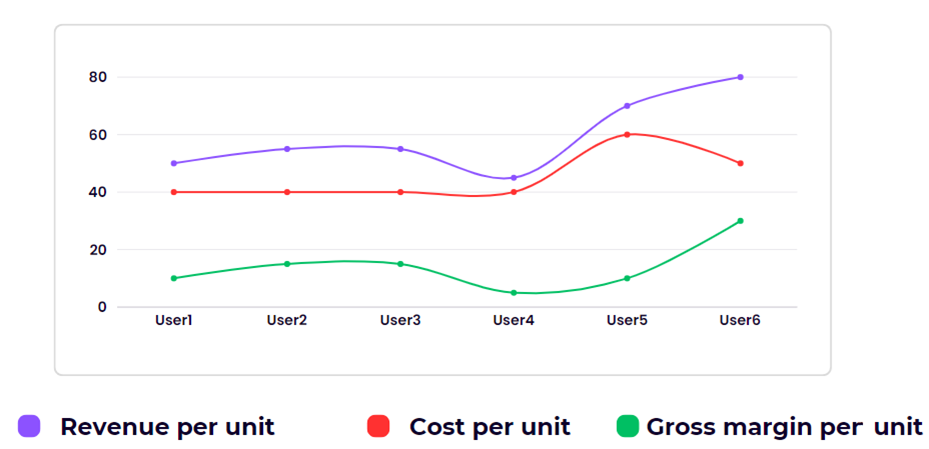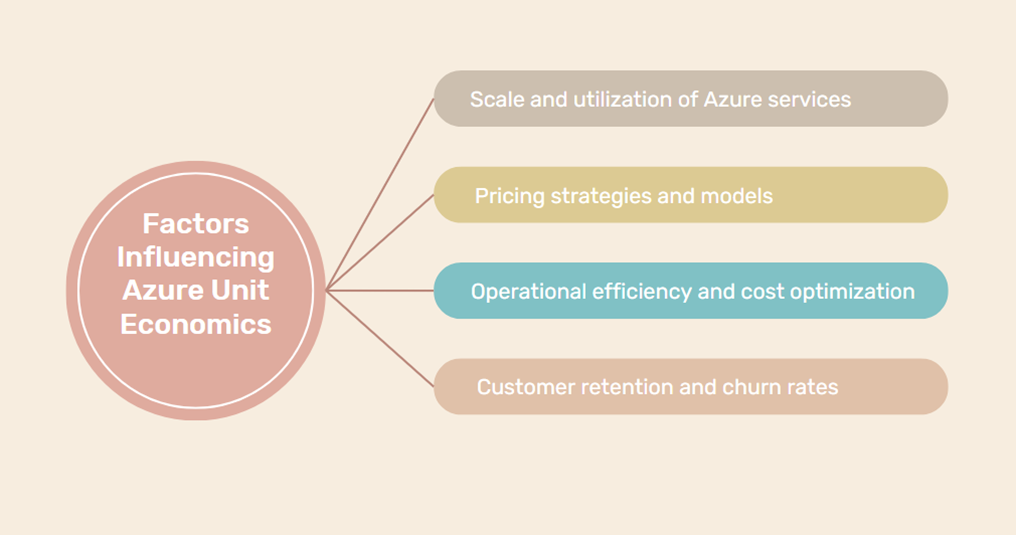Embarking on a journey through the cloud landscape, Azure Unit Economics is a compass, guiding through the intricacies of financial optimization in the realm of Microsoft Azure. This blog post aims to clarify the complexity of Azure Unit Economics, underscoring its critical role in optimizing resource allocation and ensuring cost-effectiveness within the realm of cloud computing.
What is Azure Unit Economics?
Azure Unit Economics refers to the financial analysis and evaluation of costs, revenues, and key financial metrics associated with utilizing Microsoft Azure services. This framework involves breaking down the financial components related to Azure, such as revenue per unit, cost per unit, gross margin per unit, customer acquisition cost, and the lifetime value of a customer.
By understanding and analyzing these factors, organizations gain insights into the economic efficiency, profitability, and overall financial performance of their operations within the Microsoft Azure cloud environment. Azure Unit Economics is essential for making informed decisions, optimizing resource allocation, and ensuring cost-effective utilization of Azure services.
Key components of Azure Unit Economics
Azure Unit Economics comprises several key components that play a crucial role in analyzing the financial performance of utilizing Microsoft Azure services. Here are the main components:
Revenue per unit
- Definition: The income generated for each unit of Azure service utilized.
- Significance: Provides insights into the revenue stream associated with specific Azure resources or services.
Cost per unit
- Definition: The cost incurred for each unit of Azure service utilized.
- Significance: Helps in understanding the expenses associated with utilizing Azure resources, aiding in cost management.
Read more: Azure Unit Cost Analysis for Cloud cost optimization
Gross margin per unit
- Definition: The difference between revenue per unit and cost per unit.
- Significance: Serves as a key financial metric indicating the profitability of each unit of Azure service.

Customer acquisition cost
- Definition: The cost associated with acquiring a new customer in the context of Azure services.
- Significance: Aids in assessing the efficiency and effectiveness of marketing and sales efforts for expanding Azure usage.
Lifetime value of a customer
- Definition: The long-term value derived from retaining a customer over their lifecycle.
- Significance: Provides insights into the overall financial value associated with customer retention within the Azure environment.
Understanding and analyzing these components collectively allows organizations to gain a comprehensive view of the economic efficiency, revenue generation, and cost structures associated with their usage of Microsoft Azure services. This knowledge is instrumental in making informed decisions, optimizing resource allocation, and ensuring a financially sound approach to utilizing Azure resources.
4 Key factors influencing Azure Unit Economics
Various factors exert influence on Azure Unit Economics, necessitating a comprehensive understanding:
1. Scale and utilization of Azure services
The scale and utilization of Azure services are crucial factors shaping Azure Unit Economics. Scale, representing the volume of resource usage, directly impacts cost efficiency. Efficient scaling ensures optimal resource utilization, preventing unnecessary expenses.
By dynamically adjusting to demand, organizations enhance financial performance and maintain a cost-effective approach within the Microsoft Azure ecosystem. Utilization, on the other hand, focuses on the intensity of resource usage, emphasizing the importance of maximizing the value derived from each resource.
2. Pricing strategies and models
The selection of pricing strategies and models within Microsoft Azure plays a vital role in financial success in the cloud. Azure Unit Economics hinges on the intricacies of cost structures associated with the chosen pricing approach. Whether it’s pay-as-you-go, reserved instances, or spot pricing, each model has distinct implications for budgeting and resource allocation.
Choosing the right strategy is akin to navigating the cost terrain – it profoundly impacts profitability, cost predictability, and the overall economic efficiency of utilizing Azure services. Organizations must strategically align pricing choices with their usage patterns for optimal financial outcomes in the Azure cloud environment.

3. Operational efficiency and cost optimization
Efficient operations and optimized costs are central to Azure Unit Economics within Microsoft’s cloud ecosystem. Operational efficiency involves refining processes for precise resource utilization, while cost optimization aims to trim unnecessary expenses.
This dynamic duo is pivotal for financial health, ensuring organizations run lean and smart within Azure. By continuously fine-tuning operations and adopting Azure cost optimization best practices, businesses not only streamline their finances but also maximize the value derived from Azure services.
4. Customer retention and churn rates
Within the framework of Azure Unit Economics, the dynamics of customer retention and churn rates play a pivotal role in the sustained success of organizations leveraging Microsoft Azure services. Customer retention involves fostering long-term relationships and maximizing the lifetime value of clients.
On the flip side, churn rates represent the departure of customers. Striking the right balance is essential for financial health, as high retention positively impacts Azure Unit Economics. By understanding and managing these metrics, businesses ensure a stable customer base, fostering loyalty and prolonged profitability within the ever-evolving landscape of cloud computing.
Why should you analyze Azure Unit Economics?
Analyzing Azure Unit Economics provides multifaceted advantages:
Identifying profitable Azure services
This process involves a strategic analysis of various Azure offerings to discern which services yield the most significant returns on investment. By pinpointing the high-performers, businesses can strategically allocate resources, optimize operational efficiency, and maximize overall profitability.
This keen understanding of profitability not only influences financial decisions but also ensures a streamlined and cost-effective utilization of Azure services, paving the way for sustained success in the dynamic realm of cloud computing.
Assessing the impact of pricing changes
This involves a careful analysis of how alterations in pricing structures influence the financial landscape. By understanding the ripple effects of pricing changes, organizations can make informed decisions on resource allocation, budgeting, and overall financial planning. This scrutiny allows businesses to adapt to market dynamics, ensuring that pricing strategies align with both profitability goals and customer expectations.
Evaluating the financial viability of new Azure service offerings
This process involves meticulously assessing the potential economic impact, considering factors such as upfront costs, revenue projections, and long-term sustainability. By scrutinizing the financial feasibility of introducing novel Azure services, businesses can make calculated decisions, ensuring that investments align with overarching financial objectives.
This strategic evaluation not only mitigates risks but also lays the groundwork for innovation, fostering a financially resilient presence in the ever-expanding Azure ecosystem.
Case study on Azure Unit Economics
A COVID-Era Case Study on Optimizing AI Tool Costs for an Insurance Company
Amidst the challenges posed by the COVID-19 pandemic, this case study delves into how an insurance-based company addressed a substantial surge in free-tier users for their AI tool, impacting unit economics. The urgency intensified as escalating cloud costs on Azure added complexity to maintaining profitability during this uncertain period.
Key Actions Taken
- Immediate Identification: Recognizing the pressing issue of an excess of free-tier users impacting profit margins, particularly during the uncertainties of the COVID-19 era.
- Root Cause Analysis: Pinpointing the AI tool as the source of the challenge and engaging in focused discussions to optimize its costs within the Azure framework.
- Strategic Revamp: Executing a comprehensive redesign of the AI tool, opting to enhance efficiency rather than removing it from the free tier. This decision resulted in an impressive 80% reduction in the cost of operating the AI tool on Azure.
This case study underscores the critical importance of understanding unit economics and precisely managing costs associated with specific tools, especially in the unprecedented circumstances brought about by the COVID-19 pandemic. It illustrates how strategic insights empower companies to make informed decisions, ensuring financial resilience even in the face of external challenges.
Tips and strategies to improve Azure Unit Economics
Enhancing Azure Unit Economics involves implementing practical tips and strategies:
Optimizing resource utilization and minimizing waste
Streamlining resource usage prevents unnecessary costs and enhances overall efficiency. Azure’s pay-as-you-go model encourages users to pay only for the resources they consume, reinforcing the need for resource optimization. By adopting Azure Cost Management tools, businesses can gain insights into their usage patterns, identify areas for improvement, and make informed decisions to optimize costs while maintaining optimal performance.
Continuously monitoring and adjusting pricing strategies
Regular reassessment of pricing models ensures alignment with market trends and business goals. Azure’s flexible pricing options, such as reserved instances and spot instances, provide avenues for optimizing costs based on specific business needs and usage patterns. Regularly reassessing pricing strategies enables organizations to align costs with evolving market conditions, technological advancements, and changing customer demands.
Investing in customer retention and reducing churn
Prioritizing customer satisfaction and loyalty directly impacts long-term financial sustainability. By leveraging Azure’s analytics tools, businesses can gain insights into customer behavior, enabling them to provide personalized experiences and address concerns proactively. Offering exceptional support, tailored solutions, and loyalty incentives solidifies relationships, reducing customers’ risk of switching to competitors.
Challenges and limitations of Azure Unit Economics analysis
While analyzing Azure Unit Economics, challenges and limitations may arise:
Complexity of cost allocation
Challenge 1: Allocating costs accurately in a multi-service environment is intricate, especially when dealing with interconnected systems and shared resources.
Challenge 2: Ensuring granularity in cost allocation, such as attributing costs to specific departments or projects, adds an additional layer of complexity.
Difficulty in estimating customer lifetime value
Challenge 1: The dynamic nature of customer behavior and evolving market conditions makes precise estimation of customer lifetime value a moving target.
Challenge 2: Varied customer engagement touchpoints further complicate the accurate determination of the long-term value each customer brings.
External factors impacting Unit Economics
Challenge 1: Rapid shifts in market dynamics, influenced by technological advancements or economic changes, can introduce unpredictability into unit economics.
Challenge 2: Competitive pressures and industry disruptions may affect the demand for Azure services, impacting the overall economic landscape.
Being cognizant of these multifaceted challenges equips organizations with the foresight needed to refine their approach to Azure Unit Economics analysis, fostering adaptability and resilience in the face of a dynamic cloud environment.
Future trends and outlook for Azure Unit Economics
Exploring future trends and potential developments in Azure Unit Economics includes:
Impact of emerging technologies
Trend: The integration of emerging technologies like AI and machine learning into Azure services is expected to reshape cost structures and enhance the overall profitability of cloud operations.
Outlook: Organizations leveraging cutting-edge technologies within Azure can anticipate more granular insights into resource utilization and costs, contributing to a more sophisticated approach to unit economics.
Evolution of pricing models and strategies
Trend: The cloud industry is likely to witness ongoing evolution in pricing models, with a shift towards more flexible, consumption-based structures.
Outlook: Businesses should prepare for agile pricing strategies, enabling them to align with market trends and optimize Azure Unit Economics in a rapidly changing pricing landscape.
Importance of data-driven decision-making
Trend: Increasing reliance on data-driven decision-making will continue to shape the optimization of Azure Unit Economics.
Outlook: Organizations emphasizing robust analytics and data-driven insights will gain a competitive edge, ensuring more informed and strategic financial decisions within the Azure environment.
As Azure Unit Economics charts its course into the future, these trends and outlooks offer a glimpse into the evolving dynamics of cloud financial management, providing a roadmap for businesses to stay ahead of the curve.
Conclusion
In conclusion, Azure Unit Economics is a critical aspect of effective cloud management, encompassing various components, factors, and practices. A holistic understanding and application of these aspects empower organizations to make informed decisions for sustainable and cost-effective Azure operations.











